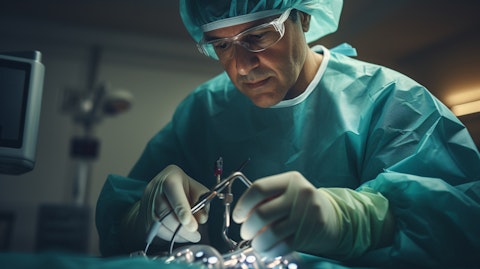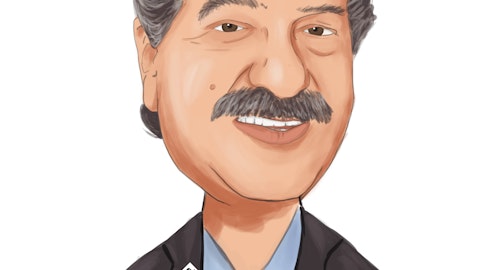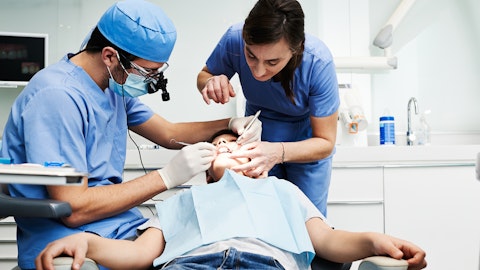AxoGen, Inc. (NASDAQ:AXGN) Q4 2023 Earnings Call Transcript March 5, 2024
AxoGen, Inc. beats earnings expectations. Reported EPS is $-0.06, expectations were $-0.09. AXGN isn’t one of the 30 most popular stocks among hedge funds at the end of the third quarter (see the details here).
Operator: Hello, and welcome to the AxoGen, Inc. 2023 Fourth Quarter and Full Year Financial Results Conference Call and Webcast. [Operator Instructions] As a reminder, this conference is being recorded. It’s now my pleasure to turn the call over to Harold Tamayo, Vice President, Finance and Investor Relations. Harold, you may now begin.
Harold Tamayo: Thank you, Kevin, and good morning, everyone. Joining me on today’s call is Karen Zaderej, AxoGen’s Chairman, Chief Executive Officer and President, and Nir Naor, Chief Financial Officer. Karen will discuss the quarter and full year 2023, and Nir will provide an analysis of our financial performance, guidance and discuss our outlook for the year, followed by a question-and-answer session. Today’s call is being broadcast live via webcast, which is available on the Investors section of the AxoGen website. Following the end of the live call, a replay will be available in the Investors section of the company’s website at www.axogeninc.com. Before we get started, I’d like to remind you that during this conference call, the company will make projections and forward-looking statements, including our expectations regarding our ability to expand our footprint, expand core accounts, anticipate growth for revenue categories, penetration of core accounts, marketing opportunities with nerve applications associated with emerging trauma, breast, OMF and surgical treatment of pain and new products, our expectations regarding the timing of our launch for Avive+, our statement regarding the timing of the complete biologics license application submission for Avance Nerve Graft, as well as statements of the timing of the approved BLA.
Our expectation is that, assuming approval of the the BLA, Avance Nerve Graft will be designated as the reference product and expected market exclusivity of such designation. Our belief that our balance sheet will continue to be sufficient to bridge through to cash flow breakeven and longer-term profitability. Our expectation is that we will continue trending towards cash flow breakeven, and our belief that trends towards operating leverage will allow us to maintain a strong balance sheet position and provide ample support as we work towards profitability. Forward-looking statements are based on current beliefs and assumptions and are not guarantees of future performance and are subject to risks and uncertainties, including not without limitation, the risks and uncertainties reflected in the company’s annual and periodic reports such as hospital staffing issues, regulatory processes and approvals, surgeon and product adoption, and market awareness of our products.
The forward-looking statements are representative only as of the date they are made and except as required by applicable law. We assume no responsibility to publicly update or revise any forward-looking statements. In addition, for a reconciliation of non-GAAP measures, please reference today’s press release and our corporate presentation on the Investors section of the company’s website. Now I would like to turn the call over to Karen. Karen?
Karen Zaderej: Thank you, Harold. And thank you all for joining us today as we discuss our 2023 Fourth Quarter and Full Year financial results. 2023 was a solid year of key accomplishments, and we entered 2024 with a strong commercialization strategy, fueled by innovation and focused execution by our sales team. Full year 2023 revenue was $159 million, a 14.7% increase compared to 2022. In the back half of 2023, we saw improved commercial execution, and during this period, we estimate that revenue from our emerging trauma procedures grew in the mid-single digits, and revenue from scheduled procedures grew above 25% as compared to the same period in 2022. As a reminder, these estimates of procedure categories are based on available data received from hospitals and sales reps and assumptions regarding specific surgeon practices and account information, and as such, are subject to the limitations of the data received and our assumptions.
We’re pleased with our progress and execution as we drive long-term growth, leveraging innovation, clinical data, surgeon education and patient activation. We’re appreciative of our ongoing surgeon engagement and feedback as they continue to integrate AxoGuard HA+ into their nerve protection algorithm, finding differentiated applications as compared to AxoGuard Classic. We’re confident that AxoGuard HA+ will expand the adoption of nerve protection products and will help more patients with nerve injuries. Additionally, we’re continuing to expand our offering for nerve protection with Avive+ Soft Tissue Matrix, which we anticipate will be commercially available in the second quarter of 2024. Avive+ is the resorable nerve protection product that functions as a barrier, providing temporary protection and tissue separation during the critical phase of healing for nerve injuries.
We believe Avive+ will be regulated as a Section 361 tissue product and will further strengthen our position in nerve protection, supporting emergent trauma and the surgical treatment of pain. In 2023, we also launched our Resensation breast neurotization technique for women who choose an implant-based reconstruction. We believe this innovative technique could apply to an additional 10% to 15% of all breast reconstruction patients. We’re pleased with the surgeon engagement, positive feedback from our educational programs, and the early adoption of this new technique. This approach will allow more patients to have the opportunity for sensory restoration, following their mastectomy and reconstruction. In August, the RECON study was published in the Journal of Hand Surgery.
The publication includes the authors’ analysis of the results, which found that Avance returned a greater degree of functional recoveries than conduits, and superiority was demonstrated as GAAP length increased. We believe that this addition of Level 1 evidence supporting the efficacy of Avance Nerve Graft in published literature continues to play an important role in surgeon clinical decision-making, especially with middle adopter surgeons. This study adds to a strong pool of clinical evidence supporting Avance Nerve Graft. In combination with the recent publications of the Meta-Analysis, the premier all payers cost comparison study and the US cost-effectiveness analysis, these four studies provide a package of compelling evidence for both clinicians and payers.
During the year, we completed the validation and transitioned into our new processing facility near Dayton, Ohio. This facility was designed for long-term growth and expansion, providing three times our previous capacity. This new facility will also support our BLA for Avance Nerve Graft. Now turning to our fourth quarter results. We’re pleased with our performance during the quarter. Revenue from the quarter increased by 18.7% to $42.9 million compared to last year. We estimate that revenue from the emergent trauma represented approximately half of total revenue and grew mid-single digits compared to last year. As a reminder, emergent trauma generally results from injuries that initially present [in an ER] (ph). These procedures are typically referred to and completed by a specialist either immediately or within a few days following the initial injury.
We believe scheduled procedures also represented approximately half of total revenue. During the quarter, we estimate that this category grew more than 25% versus the prior year. As a reminder, scheduled procedures are generally characterized as procedures where a patient is seeking relief of a nerve condition caused by a nerve defect or surgical procedure. These include breast reconstruction following a mastectomy, nerve reconstruction following the surgical removal of a painful neuroma, nerve decompression, and oral and maxillofacial procedures such as a mandible reconstruction. Strength in this category reflects the opportunity to provide improved quality of life outcomes for patients, compelling clinical data, effective surgeon education and implementation of patient activation programs.

As mentioned in today’s press release, our growth strategy continues to be focused on going deeper into core accounts where we see significant opportunity to expand our footprint. As a reminder, core accounts are defined as those generating more than $100,000 in revenue over the trailing 12 months. Revenues from core accounts represent approximately 65% of total revenue. Growth was primarily driven by increased productivity of our direct sales force as they gain deeper surgeon adoption and expanded use cases of our products within these core accounts. We ended the fourth quarter with 116 direct sales representatives, up 1 from a year ago and flat sequentially. We will continue to evaluate and add sales reps as their territories approach targeted levels.
Our direct sales force is supplemented by independent sales agencies that represent approximately 10% of our total revenue. In Q4, growth was broad-based across all applications and products. We were pleased by the contributions from innovations in new products and new applications. We continue to raise awareness of the need for nerve protection and saw expanded use of AxoGuard HA+ across both emergent and scheduled procedures. We also saw strong surgeon and patient interest in neurotization and implant-based breast reconstruction and expanded the number of surgical teams trained in this important new application. Moving on to updates on our growing body of clinical evidence. Over the years, we’ve made significant investments to develop quality clinical evidence to demonstrate the safety, performance, economics and utility of our nerve repair solutions.
Our active clinical programs are progressing as expected. At the end of the quarter, we have 245 peer-reviewed publications, including trauma, breast, OMF and pain. This January, we announced positive top line results from the REPOSE clinical study, comparing the standard-of-care neurectomy of symptomatic neuroma to neurectomy and protection of the terminated nerve end with AxoGuard Nerve Cap. This post-marketing study met its primary endpoint for reduction of pain as measured by the visual analog scale. In addition, the study investigators found that over the full 12-month course of follow-up, AxoGuard Nerve Cap demonstrated statistical superiority for reduction in total pain reported by the subjects as compared to the standard of care neurectomy.
We believe that these findings will play an important role in surgeon clinical decision making. Now turning to the BLA for Avance Nerve Graft. We’ve recently completed our productive pre-BLA meeting with the FDA. We’re encouraged by the positive interactions and have aligned with the FDA on a rolling submission process and the content of the modules for submission. We now anticipate the filing to be completed in Q3 of 2024, with potential approval in mid-2025. As a reminder, a BLA approval will complete the regulatory transition of Avance Nerve Graft from a 361 tissue product to a 351 biological product. Importantly, we believe Avance will be designated as the reference product for potential biosimilars, providing 12 years of market exclusivity.
With over 100,000 Avance Nerve Grafts implanted since launch, we are well positioned to continue to lead and innovate in the large and developing peripheral nerve repair market. I’m proud of our team, and I look forward to continuing our mission of revolutionizing the science of nerve repair. Now I’ll turn the call over to Nir to provide a review of our financial highlights and guidance. Nir?
Nir Naor: Thank you, Karen. I’m very happy to participate in my first call. It’s been great three months ramping up and meeting people on the team. I’m very excited about the AxoGen story and the potential of the company. And moving to the financial results. For this quarter, our revenue reached $42.9 million, [Technical Difficulty] 18.7% growth from the fourth quarter of 2022. This growth is attributed to a 10.5% increase in unit volume, added with a 4.9% mix favorability, and a 3.3% increase in price. We estimate that revenue for emergent trauma represented approximately half of total revenue and grew mid-single digits compared to last year. We estimate that revenue from scheduled procedures represented approximately half of total revenue.
During the quarter, we estimate that this category grew more than 25% versus the prior year. Our gross profit for the quarter was $33.8 million, an increase from the $30 million recorded in the fourth quarter of 2022. This represents gross margin of 78.7%, down from 83% in the same period last year. This change is mainly driven by the costs associated with starting tissue processing at our new facility. Our total operating expenses for the quarter increased by 3.7% to $37 million, up from $35.6 million in Q4 of 2022. Specifically, our sales and marketing expenses for the fourth quarter grew by 11.6% to $22.2 million. Sales and marketing expenses, as a percentage of total revenue, decreased to 51.7% from 55% in the fourth quarter of 2022 as we saw improved sales force productivity.
Research and development expenses increased by 7.2% to $7.3 million from $6.8 million in 2022, driven by costs related to the BLA. As a percentage of total revenues, total R&D expenses reduced to 17%, down from 18.8% in the last quarter of the previous year. General and administrative expenses decreased by 16.3% to $7.5 million in Q4 of 2023 from $8.9 million in Q4 of 2022, driven mainly by [its stock on forfeitures] (ph) due to the departure of executives from our company. The quarter ended with a net loss of $3.9 million or $0.09 per share, compared to a net loss of $5.4 million or $0.13 per share in the fourth quarter of 2022. However, we recorded an adjusted net loss of $2.6 million for the quarter, translating to roughly $0.06 per share, a shift from an adjusted net loss of $1.1 million or $0.03 per share in the same period last year, driven in part by one-time severance costs.
Adjusted fourth quarter EBITDA was $0.6 million compared to an adjusted EBITDA loss of $0.7 million in the prior year. As of December 31, our balance of cash, cash equivalents and investments was $37 million compared to $38.6 million at the end of the third quarter. Turning now to our guidance. As outlined in today’s press release, we are issuing our full year guidance for 2024. We expect revenue to be in the range of $177 million to $181 million, which represents an annual growth rate of approximately 11% to 14%. Additionally, we anticipate gross margin for the full year to be in the range of 76% to 79%. In the future, we expect our gross margin to benefit from improved capacity utilization of our new processing facility as our sales volume of Avance increases.
And in summary, we’re pleased with our fourth quarter performance. We will continue to execute our strategies, invest in innovation, improve our productivity and drive towards cash flow breakeven and profitability. And this time, we’d like to open the line for questions. Kevin?
See also 15 Best Places to Retire in Arizona and 13 Best Dividend Stocks For Rising Interest Rates.
Q&A Session
Follow Axogen Inc. (NASDAQ:AXGN)
Follow Axogen Inc. (NASDAQ:AXGN)
Operator: [Operator Instructions] Our first question today is coming from Chris Pasquale from Nephron. Your line is now live.
Chris Pasquale: Thanks. Karen, Avive was annualizing at close to $8 million in sales before you pulled it off the market. Is there any reason to think that Avive+ won’t ramp to that same level relatively quickly? And how do you think about how much of that is incremental versus cannibalistic to your existing portfolio?
Karen Zaderej: Yeah. Just to remind people Avive and Avive+, we previously had a product that we launched that was Avive that we withdrew because of changes in regulatory classifications from the FDA, and we’ve launched Avive+ to help move back into that segment of a temporary protection barrier, which we think is an important tool for surgeons. I don’t think it’s going to be an immediate ramp up, so I don’t want to overplay that as something that’s going to completely pop into this next few quarters. We do have some surgeons who are very anxious to get this product because they used it — they used the prior Avive product as an important part of their nerve treatment algorithm. So I’d be more cautious than that and just say I think it’s going to continue to help complement the protection business that we have and allow us to continue to see growth overall in protection but it won’t ramp immediately up into that size of revenue.
There is some cannibalization. Surgeons had to turn to another tool when they no longer had Avive on the market. So there will be some cannibalization where the surgeons were using alternatives of our other products to try and still provide some protection for their nerves. But we do think most of the Avive business will be a new business for us. So it will — while there will be some cannibalization, it will be predominantly new.
Chris Pasquale: Thanks. And then Nir, just a question about the cadence of gross margin during 2024. The guidance is a little bit lower than what we were thinking. I’m assuming that’s related to the new facility. Can you give us some sense of what the first half looks like versus the second? And whether you see a pathway back to the 82%, 83% margins the company enjoyed a year ago?
Nir Naor: Yeah. Thank you for the question. So yeah, so indeed, as we mentioned, we fully transitioned to the new processing facility end of last year. It is an important milestone for BLA. It is designed for long-term growth and basically has capacity, which is three times our previous one, which is very good for long-term potential and the margin. That said, in the short term, it’s running at a fraction of its total capacity. And this is one of the drivers for the lower margin. And we’re ramping it up, learning about the various benefits of capacity and other efficiencies. That said, we wanted to give guidance that we feel fully confident with. We expect the margin probably in the later half of the year to be on the lower side versus the first half of the year. Nonetheless, this is our average. And then long term, definitely, we expect the margin to benefit from higher sales, higher production and higher capacity utilization.
Chris Pasquale: Sorry. So just to confirm, we should expect sequential decreases in gross margin through the year? Not a first half dip and then a second half rebound?
Nir Naor: Right. I mean, basically, we’re selling an old inventory, which was produced in the prior — the previous facility. So this is why the second year might be a bit lower. But again, we’re learning all of those impacts, as I said, of the new facility. And for the total year, our guidance was — we said 76% to 79%, with definitely a clear expectation for improvement in the longer term.
Chris Pasquale: Great. Thank you.
Operator: Thank you. Next question is coming from Mike Sarcone from Jefferies. Your line is now live.
Mike Sarcone: Good morning and thanks for taking the question. I guess just to start on the guidance, the 11% to 14%, can you just talk about what’s baked in, in terms of scenarios in healthcare utilization environment at the low and high ends of the range?
Karen Zaderej: Yeah. So we’re looking at continuing to see measured growth through the year, driven predominantly by productivity improvements with our existing sales team. So think of it as about the same number of reps, maybe up or down a few, but in the same side, not a big expansion of sales team, so it’s driven by productivity, and a real focus in driving that growth in our core accounts. So that’s our strategy. That’s how we think we’re continuing to build this out. And we’ve drawn that out and have taken what we think is a measured approach in thinking about our overall growth.
Mike Sarcone: Okay. And I guess, can you provide any color on how you’re thinking of the growth differential in 2024 between emergent trauma and scheduled non-trauma? Can you break that out for us or help us think about that?




